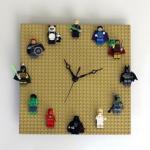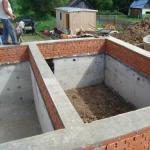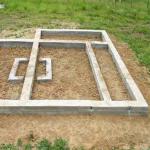Laying brick partitions is necessary in cases where a full-fledged structure is required to divide a significant space. A brick partition is not only a strong and reliable structure, it provides effective sound and heat insulation and allows you to create an additional room in an existing living space. Such a structure is durable, reliable, and resistant to various types of negative influences such as humidity and temperature changes in the surrounding space. In addition, stationary brick interior partitions do not serve as load-bearing walls.
Design Features
The main feature of a brick partition built in an apartment with your own hands: durability, strength and reliability. The construction of such structures begins after all major construction work has been completed:
- load-bearing walls were erected,
- reinforced floors;
- floors and walls are completely dry.
The construction of brick partitions has certain distinctive features. Their construction requires compliance with the rules of construction work. It is in accordance with these requirements that the load on the floors is calculated, allowing cracking of the floor or ceiling. Since the weight of the structure is quite large, its construction in most cases is carried out on the 1st floor of the building or exclusively on reinforced concrete floors.
The use of hollow bricks for partitions can significantly reduce the weight of the structure. Another way to lighten the structure is to build a half-brick partition or use porous brick blocks.
When performing work on creating brickwork partitions, it is necessary to take into account the microclimate in the room where construction is taking place.
To build an additional internal wall with your own hands in the bathroom or when adding a balcony to the kitchen or living room, it is better to use red solid brick. Its main distinguishing feature is high moisture resistance. Such blocks practically do not absorb moisture and are not susceptible to the formation of mold and mildew on the surface.
The installation of brick partitions requires careful sealing of cracks and cracks through which insects can enter the room. This condition can be met with the help of a high-quality solution prepared according to all the rules. Only this composition will provide:
- reliable and high-quality adhesion of blocks;
- strength;
- durability of the structure.
The second no less important condition is the competent connection of the partition to the load-bearing wall. To do this, you will need to make grooves in the main walls into which new bricks are laid. It is necessary to lay waterproofing material between the first row of bricks of the future partition and the floor. Roofing material laid in 2 layers will not only guarantee high-quality moisture insulation, but will also dampen possible vibration.

The laying is carried out with bricks previously moistened with water. It absorbs less moisture from the solution and adheres better. Considering the need for subsequent plastering work, the seams between the bricks of the partition are not completely filled with mortar. This type of masonry is called “wasteland”. Its feature is better adhesion of the plaster mixture to the surface of the constructed wall.
Preparation
Laying a partition indoors is a job that can be done independently, without resorting to the services of specialists, if you strictly follow the instructions and observe the rules and nuances of the technological process. First of all, you need to take care of preparing the material and tools:
- To create the solution you will need clean sifted sand, M100 cement, and cold water. Having mixed the main components in a 3:1 ratio and adding water at the rate of 0.5 liters per 1 kg of cement, you can begin mixing. For greater convenience, you can add a plasticizer, but experienced craftsmen sometimes replace expensive products with the usual Progress composition. This is a soap solution that prevents the composition from “settling” too quickly.
- Knowing the dimensions of an individual brick block and the area of the future partition, you can calculate the amount of brick that will be needed for construction. It is folded so that it always remains in the free access area.
- Before you begin work, you should prepare a string, a hammer-pick, a building level, a plumb line, a trowel and a hammer drill.
- The first thing you need to do is prepare the construction site, you need to make a groove in the load-bearing wall for tying, sweep out debris, clean the floor surface and place a double layer of waterproofing material on it.
The thickness of brick partitions in most cases does not exceed half the product. Knowing this, you can calculate the required amount of material. Now you can prepare a container, a construction mixer or a drill with an attachment for mixing the solution and begin preparing the composition.
While the prepared solution is infused, you need to lay out the first row “dry”. This means that this operation does not require a solution. The first row of bricks will show not only the number of solid brick blocks, but also the number of halves, which are best prepared in advance.
The boundaries of the future partition are marked both on the floor and on the walls of the room with which the structure will border or come into contact. The thickness of the partition deserves special attention.
If the thickness of a brick partition exceeds half a brick, this structure is called a wall.

This design requires additional load calculations, preparation of a project for redevelopment of the premises and permission for construction. No special documentation is being developed for interior partitions. Lightweight structures do not cause premature destruction of the building and can be removed at any time.
Work order
Having prepared everything you need, you can begin marking. The importance of this operation cannot be overestimated. Incorrectly executed markings will cause premature destruction of the entire structure created by yourself. On the internal surfaces of the load-bearing walls to which the partition will adjoin, vertical and horizontal lines should be noted. This is done using a laser building level and a plumb line. All further manipulations are performed under the constant control of a level (laser level).
During marking, the contours of the future partition are marked on the floor and walls, which will have to be adhered to during construction. The masonry begins with the waterproofing being laid according to the markings made and the first row of bricks being laid on it. A layer of mortar will eliminate all existing irregularities, and the quality of the first row of masonry is checked using a building level of the maximum possible length.
Before starting the laying of the second row, dry laying is done again, placing the bricks so that the seams run apart. The seams between the bricks of the first row should fall in the middle of the block of the second row. It is this method of constructing interior partitions made of brick that guarantees their strength, reliability and durability.
The quality of further masonry and the level of complexity of subsequent work depend on how correctly and accurately the bricks of the 1st row are laid.

It is impossible to achieve correct masonry by trying to eliminate errors by changing the thickness of the inter-row seam. Its thickness should be the same between all rows. A string stretched between 2 nails, which are simply inserted into the not yet hardened mortar of the seam of the previous row, will help to monitor the correct laying of the brick, straightness and location of all components of the structure in the same plane. This will help avoid the formation of the so-called “belly”.
You can quickly and efficiently complete the laying as follows:
- A strip of mortar no more than 10 cm wide and 1.5-2 cm thick is laid on the waterproofing.
- The first row of bricks is laid on this strip, under the control of the building level. If it is necessary to hide the unevenness of the floor, you can carefully tap the brick or slightly increase the thickness of the mortar layer.
- The second row is laid out, starting from the sides (outermost bricks in contact with the walls). After checking the quality of the binding, lay out the blocks towards the middle of the partition.
- To create a 3rd row, you can use nails and lace, which will not allow you to violate the established boundaries of the plane and will help maintain the evenness of the partition.
The bricks are laid on the mortar, leaving the joint space between them empty. After making sure that the masonry is correct, the horizontal seams are also filled. Thus, it is possible to carry out laying in a “waste area”, ensuring in advance the creation of a high-quality and reliable plaster layer.
The process can be seen in more detail in the video:
The arrangement of internal partitions made of brick is considered a traditional, “classical” way of constructing such structures.

When laying bricks next to the door frame in a row, it is necessary to lay L-shaped brackets.
They are characterized by durability, strength, and a high degree of fire resistance.
The mineral nature of the material provides a high level of sound insulation, and the absence of cavities does not allow rodents to infest. The downside is that such a structure has a considerable weight, and laying brick partitions is considered a “wet” job involving the use of cement mortar.
Features of construction

Rules for laying out bricks: a - 2.5 bricks, b - 1.5 bricks, c - 1 brick; 1 - for the tychkovy verst, 2 - for the spoon verst.
In order to somehow smooth out the main drawback, partitions are usually placed in half a brick (12 cm) or on an edge (the resulting thickness is 6.5 cm). Hollow bricks are also sometimes used, but then the quality of sound insulation decreases.
Installation of structures is carried out before the installation of a cement screed. To ensure maximum stability and adhesion to the building, metal reinforcement is inserted into the floor slab (base) by drilling, which is then secured in the vertical seam of the partition.
In some cases, it is possible to attach to the ceiling using metal profiles and dowels. It is necessary to level with cement mortar the part of the base on which the partition will rest. It is undesirable in places with high humidity, since it does not have sufficient resistance to its effects. After erecting the partition, the surface must be plastered.
The thickness of only 12 cm makes it necessary to take additional measures to strengthen the brick structure. Reinforcement is usually used: after 4-5 rows, metal reinforcement or fine mesh is placed in a horizontal seam, the ends of which are inserted into one of the main structures of the building or secured with dowels. If it is long, then additional vertical reinforcement is used with the help of rods and mesh, passed through the seams and fixed at the base. Particularly difficult is the construction of a partition less than 12 cm thick, that is, “on the edge” of a brick. Such a structure is very shaky, so construction is usually carried out in stages, with the construction of 4-5 rows and their subsequent drying.
Preparatory work

The general construction plan indicates all partitions, their sizes, as well as methods and materials of fastening to load-bearing walls.
At the first stage, it is necessary to take measurements of the future partition in order to calculate the required amount of brick. The brick structure can have a thickness of 12 or 6.5 cm (the stone is placed on its edge). The dimensions of a standard brick are 250x120x65 mm; when calculating, take into account the thickness of the mortar joint, which is 12 mm.
To build a structure at a height, you will need trestles, which can be made from available materials - boards, bars. You can also make a container for mixing the solution (if you don’t have one) yourself - to do this, take a 200-liter steel barrel and cut it lengthwise with a grinder. All that remains is to place the bars for stability - and you can knead!
The solution requires high-quality sand. You can use regular one, after sifting it first. To do this, use a metal mesh; fits well with the old, “Soviet-style” bed. In addition to bricks you will need:

The partition in the brick floor must be additionally secured at the junction of the load-bearing walls.
- cement (grade not lower than M500);
- water;
- mason's hammer ("pick");
- trowel or trowel;
- reinforcing bars or fine mesh;
- dowels or metal profile for attaching a 12 cm thick brick partition to the base;
- building level, plumb line;
- rule (well-planed strip 1.5-2 m long);
- nylon cord.
If necessary, plastic additives can be purchased to add to the solution. They can prolong the “workability” of the mixture or ensure its quality at low air temperatures. The door frame is installed in advance and fixed with spacers.
Construction of a brick partition

When carrying out masonry, a nylon cord (order) is usually pulled so that the masonry is carried out strictly horizontally.
Prepare the base: clean it down to the floor slab. If there is plaster on the walls, it must be knocked down. Clean the surface to which the partition will adjoin with a broom from dust and moisten it with water. Place the brick so that it can be easily reached without getting in the way.
- First you need to mix the solution at the rate of 3 parts cement and 1 part sand. To do this, pour both ingredients into a half-barrel and mix dry with a shovel. Then make a funnel in the middle and add water there, mix everything. The finished mixture should resemble the consistency of good sour cream. The solution dries quite quickly, so mix it for no more than an hour of work. If the mixture begins to harden, simply stir it (it is not recommended to add water).
- In the place where you plan to lay the first row of a 12 cm brick partition, pull a nylon thread. Using it as a guide, place the mortar (its strip should be a little wider than necessary) and bricks on it. They must be carefully leveled. The first row should be as horizontal as possible.
- When laying bricks next to the door frame in a row, it is necessary to lay L-shaped brackets that will fix the frame in the desired position. Laying is carried out in compliance with the order, i.e. the vertical seams should not coincide. Bandaging allows you to make the wall monolithic.
- After the laying of the 1st row is completed, proceed to the second. To do this, pull the cord and lay out a row along it. Check each laid stone with a building level, as a rule, and starting from the 3-4th row, use a plumb line to check verticality.
- Every 3-4 rows it is necessary to carry out reinforcement using a fine mesh. Its fastening is carried out using dowels nailed to the walls. As a lintel over the doorway, you can use a channel or a wooden block wrapped in waterproofing material (for example, roofing felt).
- When the brick wall reaches the ceiling, a small gap will remain. To fill it, you can use fragments of broken bricks, which must be covered with mortar. During work, constantly monitor verticality using a plumb line and horizontality using a level; Then it will be very difficult to correct the flaws.
After the laying of the 12 cm brick partition is completed, you can immediately begin plastering the surface. If it was used, then during the work the mason must embroider the seams with a special tool. If you intend to carry out any communications, then you should acquire in advance sections of metal pipes of suitable diameter and length. The resulting gap is best sealed with foam. Before the solution in the partition has more or less set (7-10 days), the wall cannot be touched.
Basic rules for the construction of partitions
- Sometimes a 12 cm brick partition is laid to achieve the best sound insulation with the aim of constructing a double wall with an air gap. For the same purposes, roofing material (double layer) is laid over the ceiling. Even better results can be achieved if you use a cement-sand mortar to install one of the walls, and a lime-cement mortar for the other.
- If the partition of 12 cm is small or the stone is placed on its edge, then it is possible to use templates according to which the first couple of rows are laid out.
- Before installation, the door frame must be treated with antiseptic and fire-resistant compounds.
- If 12 cm brick partitions are installed in a new house, then it is better to install the mortgages for attaching them to the walls in advance.
Brick walls freely allow the mounting of any shelves, cabinets and equipment. A well-laid partition will not only fulfill its main function, i.e., divide the living space, but also provide good sound insulation between the individual parts of the room and comfortable living.
In this article we will learn how to make a brick partition with your own hands. There is nothing overly complicated in this work; you should approach the work carefully and follow all the points in this article.
What do we make a partition from?
Partitions should be made of ordinary red single brick. Hollow brick is not particularly suitable for laying a partition, especially if electrical communications will be embedded in the surface. With this work, the integrity of the brick can be damaged and the partition will not be strong and reliable. The main requirement for installing a brick partition is a reliable foundation for this structure. If the partition is laid on reinforced concrete floor slabs, then no additional work on its installation will be required. The ceiling itself serves as an excellent basis for a partition.
Foundation
If during the construction of a house wooden floor beams are used to install partitions, it is necessary to make a simple strip foundation. The width of the foundation is taken to be 200 - 250 mm, and its depth must be at least 250 mm. In a house with a basement and wooden beams, brick partitions should not be installed.
Before starting work, horizontal waterproofing is installed on the surface of the foundation using roofing felt and cement mortar. Waterproofing is not required for reinforced concrete floor slabs.
Marking
Work begins with marking the partition in the right place. The vertical lines of the edges of the partition are drawn along the walls using a level or plumb line, and the outline of the structure being built is also marked along the floor slabs. Doorways are marked on the surface of the slabs or foundation.
Masonry process
The masonry of partitions is usually made with a thickness of 120 mm; this size is sufficient to construct a reliable partition. Sometimes quarter bricks are laid to save material, but this should not be done. As a last resort, a quarter-brick partition can be made with a partition length of no more than 2 - 2.5 meters, otherwise the structure will not be reliable enough.
Masonry begins from load-bearing walls and doorways. Raise several rows of bricks and check the verticality of the partition using a level. Then a cord is stretched between the laid out parts of the partition and the rest of the brick is laid along it. Then several rows of bricks are laid out again along the edges of the partition, the cord is pulled, and the work in this sequence is carried out to the desired height.
After 3–5 rows, the masonry should be reinforced with a masonry mesh or two small diameter reinforcement bars. Partitions are usually attached to load-bearing walls also using a masonry mesh; it should be released a few centimeters from the load-bearing wall during the construction of the outer walls. If the mesh was not previously embedded in the wall, you will have to secure anchors and attach the partition reinforcement to them.
The masonry is made with ligation of vertical seams without jointing them. If finishing work on the partition will not be carried out in the future, the seams should be carefully unstitched. For plastering work, it is better to do the masonry “in the waste area”, i.e. no need to painstakingly seal the seams. In this case, the layer of plaster will be more securely bonded to the brick.
Doorways
When constructing doorways, they should be made 1–2 centimeters larger in height and width, then the door frames will be mounted without problems. Lintels over openings can be mounted in several types: ready-made concrete lintels, from two corners with a 50 mm flange, you can put several reinforcing bars. The main thing is that the support of any lintel is at least 80 - 100 mm. When laying a brick partition, it is necessary to leave a small gap between the floor slab and the top row of bricks. In case of shrinkage of the building, breakage of the brick in the partition will be prevented; this gap can be filled with polyurethane foam.
To divide the interior space of a room into separate zones, to delimit rooms from each other, or to perform redevelopment, the construction of partitions is required. Laying brick partitions is one of the most popular options. They are distinguished by their strength, durability, good sound insulation characteristics, and resistance to moisture.
Of course, the construction of structures such as brick partitions can be entrusted to professionals. However, if you wish, you can save on paying for their services and do the work yourself - the main thing is to approach this issue responsibly and follow the installation technology.
Main types of bricks
Bricks for partitions can be selected based on financial and economic considerations. It is important to take into account the characteristics of each variety in order to choose the best option for a particular case.
There is a whole set of parameters on the basis of which bricks are classified:
| Options | Varieties | Notes |
| size | Single (250 x 120 x 65 mm) | The most convenient for the construction of brickwork are single and one-and-a-half varieties. |
| One and a half (250 x 120 x 88 mm) | ||
| Eurostandard (250 x 60 x 65 mm) | ||
| Double (250 x 120 x 138 mm) | ||
| filling | full-bodied | Solid bricks are distinguished by higher strength and durability, while hollow bricks are distinguished by lower weight and better thermal insulation properties. |
| hollow | ||
| appointment | private | Used for the construction of the main masonry. |
| facing | Used in finishing works. | |
| stove | Designed for laying stoves. | |
| Manufacturing method and material | ceramic | Material: clay. The manufacturing method is firing at high temperatures in a special furnace in order to give the material the necessary strength characteristics. |
| Silicate | The material is a mixture of quartz sand, air lime and additives (in some cases, pigment is added to the composition to give a certain color). Manufacturing method: semi-dry pressing followed by autoclave treatment with water steam. |

Like any other structural material, brick has its advantages and disadvantages.
Among the advantages should be highlighted:
- Strength. Thanks to this characteristic, load-bearing walls and partitions made of bricks are subject to long-term and safe operation.
- Moisture resistance. Brick tolerates moisture well, so partitions made from this material can be erected in premises for any purpose - for example, a brick partition in a bathhouse is the optimal solution.
- Soundproofing a brick partition. Even a half-brick partition can provide a good level of noise protection provided that a layer of plaster is applied to it (the sound insulation index of a 100 mm thick brick partition is 42 dB, after plastering the indicator increases by 3 dB).
- Aesthetics. Ceramic brick masonry is suitable for almost any finishing work. In addition, such designs look aesthetically pleasing even without additional decorative coating.
- Fire resistance. The brick is suitable for the construction of fire partitions, including in bathhouses. The fire resistance of a 120 mm brick partition is 150 minutes, while the fire resistance limit of a 0.25 m thick brick wall will be 330 minutes.
As for the shortcomings, there are few of them:
- complexity of the work;
- the need to prepare a solid foundation;
- heavy weight of the finished structure.
Before you start building a brick partition with a thickness of 120 mm or less (with a greater thickness, the structure is already considered a wall), it would be a good idea to familiarize yourself with the recommendations that will help save time, effort and money when installing this structure:
- Installation on the ground is not allowed (including in basements). Before starting masonry work, you will need to arrange a small foundation:
- prepare formwork according to the width of the future wall;
- Place reinforcing mesh on its bottom (rod diameter 0.8 - 1 cm);
- pour concrete solution (layer of at least 300 millimeters);
- lay out another reinforcing mesh (rod diameter 0.6 - 0.8 cm);
- pour concrete solution (finishing layer);
- arrange waterproofing from glass insulation or roofing felt.
- Interior partitions made of bricks are a serious additional load on load-bearing structural elements; to reduce it, you can use hollow varieties. But if the structure is installed in a bathroom, kitchen, toilet or other room with high or variable humidity, then it is permissible to use only solid brick.
- If a brick partition is erected after major construction has already been completed, then it can be connected to the main wall using metal pins.
- Brick partitions cannot be installed on plank or parquet floors - the wood may collapse under the load of a massive structure, which will lead to subsidence of the latter.
If the length of the partition exceeds 300 cm, then it must be connected to the ceiling structure. 
Technology for constructing a brick partition
The following step-by-step instructions will help you complete the construction of a brick wall yourself:
| Step | Description | Note |
| Marking | · make the necessary measurements (if you plan to plaster the partition, then the thickness of the brick structure should be taken into account along with the thickness of the layer of finishing material); · use a marker or pencil to mark the points where the future partition will be located; · if a doorway is provided, place the appropriate risks; · using a building level, draw vertical lines on the walls (this will help to control and promptly eliminate possible deviations of the structure from the vertical position). |
For interior partitions, in most cases, the method of laying bricks on an edge is used. In this case, take into account the thickness of the brick partitions of 12 cm and add to it the average thickness of the plaster layer - 3 cm. |
| Installation of "beacons" | - one brick is installed at a right angle to the load-bearing wall, limiting the future partition on one side. A second brick is installed at the opposite end. | The horizontality of the line between the “beacon” bricks is checked using a regular cord (it can be adjusted if necessary). |
| Preparation of the solution | You can use ready-made dry mixtures or prepare a septum solution yourself. Classic masonry mortar consists of the following components: - sand (it must be sifted first) - 4 parts; — cement – 1 part; - water - 1 part (add it in small portions, constantly stirring the composition to obtain the desired consistency). To increase the level of moisture resistance, clay (finely ground) is added to the composition - this option is suitable if a partition is being built in a brick bathhouse. When we are talking about a room with normal temperature conditions and moderate humidity (for interior partitions), it is permissible to add lime to the solution in order to reduce the amount of cement required. |
In any case, the masonry mortar should be of medium thickness. A composition that is too liquid will have a bad effect on the quality of the finished structure, as it will simply pour out of the seams, while a solution that is too thick will result in thick seams, which also does not benefit the strength and aesthetic characteristics. Modern dry construction mixtures are of good quality and easy to prepare (it is enough to simply dilute them with water in accordance with the instructions), so many craftsmen opt for ready-made mixtures. |
| Masonry device | 1 Laying bricks “dry” (that is, “rough masonry” without mortar). | Makes it possible to determine the number of whole bricks in one row. This is especially relevant if it is necessary to provide a doorway in the partition. |
| 2 Laying a leveling layer of mortar. | ||
| 3 Laying out the first row of bricks. | After completing this step, you need to check the quality of workmanship using a plumb line and a building level. | |
| 4 Lay out rows 2 to 5. | The laying of each subsequent row should be carried out with “bandaging” of the seams - that is, the seam between two bricks of the second row should be located above the middle of the base brick, and so on. This will ensure high strength of the finished structure. | |
| 5 Reinforcement of masonry using wire mesh. | It is recommended to use wire with a thickness of 0.4 to 0.6 cm. The maximum height of the partition is 3.25 m without reinforcement. The height of a brick partition with reinforcement can reach 3.9 m. |
|
| 6 Checking the level of the horizontal and vertical plane of the wall. | SNiP allow a deviation of the structure from the vertical by 10 mm per meter of height of the structure, but in the case of partitions in an apartment it is better to do without deviations. | |
| 7 Repeat steps 4 – 6 until the required height of the partition is reached. | After a part of the partition with a height of 100 - 150 cm has been laid, it is necessary to take a break from work for 24 hours. This is necessary due to the instability of the structure made of bricks placed on edge until the mortar gains strength. | |
| 8 Install the lintel / arrange the formwork at the height of the door frame (if necessary). | ||
| 9 Seal the gap between the ceiling and the top row of bricks. | Usually, when installing a brick partition, a gap of about 1 cm wide remains between the structure and the ceiling. It should be filled with tow. If the gap is larger (most often this happens when building brick partitions in wooden houses), then it can be filled with a mixture of mortar and fragments of bricks. | |
| Plastering the partition (provides additional sound insulation, as well as decorative properties) | · clean the surface of the wall from dried particles of the solution and settled dust; · attach the guides (they will set the thickness of the plaster layer) at a distance equal to the length of the rule; · before finishing the internal partitions in the apartment, lay polyethylene at the base of the partition to protect the floor from splashes and drops of solution; · slightly moisten the surface of the wall; · dilute the dry plaster solution in accordance with the instructions; · take a little solution onto a spatula and forcefully throw it onto the partition; · smooth out the applied solution using a spatula; · Apply a finishing layer of putty. |
At least 24 hours must pass between the completion of masonry work and the start of finishing. Plastering is usually done using the spray method - it requires certain skills. After the putty has been applied, the wall can be painted or wallpapered. |

Building a brick partition yourself is not as difficult as it might seem at first glance. If you follow the instructions exactly, the structure will be strong, stable and durable, and the acquired masonry skills will definitely come in handy in the future.
Videos on the topic
To make it easier for you to master the technology of constructing such partitions, we recommend watching several videos

Types of partitions
The purpose of partitions is to divide into parts the internal space of the house, enclosed by load-bearing walls.
Brick partitions are laid out with a thickness of 12 cm (in ½ brick) and 6.5 cm (brick “on edge”). When the length of partitions laid out “on edge” is more than 1.5 m, they are also reinforced with wire every 2-3 rows in height.
The thickness of brick partitions is equal to ¼ brick for a partition length of up to 3 m and a height of up to 2.7 m, and for longer lengths and heights – ½ brick. In cases where it is necessary to make a ventilation duct in the partition, their thickness must be increased to 38 cm.
The partitions are laid on a mortar of grade no lower than 100, for stability they are reinforced with steel reinforcement rods with a diameter of no more than 6 mm, and in places where they interface with the walls, they are driven in with steel ruffs or pins.
For laying the corners of partitions with a thickness of ½ and ¼ brick, templates are used from boards, planed on the outside and planed on the inside working side. The template is installed along a plumb line - at a distance between the floor and ceiling of the room. Corner bricks are laid close to the template with bandaging.
To give the partitions rigidity every 5–
6 rows of masonry lay two rods of reinforcing wire with a diameter of 3–
4 mm at a distance of 20 mm from the edges of the septum.
To ensure that the partitions are held firmly between the walls, through grooves (grooves) or separate holes (sockets) with a depth of 2 are punched into the latter–
5 cm. Nests are chosen so that every 5– 6 rows 2 – 3 rows of masonry partitions could jam in them.
Laying brick partitions
It is best to do the masonry by emptying it, followed by plastering with lime or lime–
gypsum solution.
The top of the masonry partition often does not reach the ceiling by 2–
5 cm. Sometimes this space is filled with mortar and pieces of brick. You can also fill it with tow soaked in gypsum solution and compact it well. When the gypsum sets, it expands and adheres tightly to the partition and ceiling.
The necessary rigidity of the partition is given by mandatory wedging every meter, as well as placement in every 2–
m row of soft wire with a diameter of 2.8 mm stretched and fastened to nails. If the partition sways and its rigidity is questionable, this is the result of poor wedging. It is not recommended to wedge the partition immediately after installation, since the solution in it cannot yet fully withstand the pressure and, when wedging, begins to be squeezed out of the seams. It is best to carry out wedging the next day, when the solution reaches the required strength.
It is impossible to obtain the required rigidity of the partition with loose and weakly tensioned wire. It is also very important to ensure the rigidity of the brick partition with a thickness of ½ brick. They often make a mistake when, when remodeling premises, they forget to make a connection with the walls half a brick deep at the four corners of the partition.
Until the required strength is achieved (8–
10 days) the bathroom partitions must not be touched.
Soundproofing of partitions
D To eliminate audibility between apartments, double partitions are erected with an air gap between them 2 – 6 cm. Practice shows that such a solution is effective only if the walls are erected without deviations from the technology requirements. Often walls are laid everywhere in the same way, on the same mortar, hence the frequency of their own vibrations will be the same, which negatively affects sound insulation. Good sound insulation is obtained by laying one of the walls on lime, the other on reinforced lime.– cement mortar. Sound insulation is compromised if the resulting air gap in the wall is narrowed either by protruding bricks or mortar. It is unacceptable for the walls of the double partition to touch each other.
To prevent sounds from penetrating from below, the partition is installed on a double layer of roofing felt. A good effect is obtained by making a gasket under the partition from cork or other soundproofing material. For more information about modern materials and technologies for sound insulation of partitions and walls, see the specialized website
shumoed.ru
Laying partition junctions
When crossing walls, the butt rows of one wall are moved a quarter of a brick away from the other wall and quarters are laid in this gap. With subsequent spoon rows, the bonded rows of both intersecting walls are tied into ¼ or ½ bricks. In this case, when intersecting the rows of spoons, the intersecting walls do not seem to pass through the main wall, but only go deeper into it by ½ brick.
Mistakes when installing brick partitions
A typical mistake during reconstruction and redevelopment of apartments is installing a partition on the surface: parquet, plank flooring. In this case, the floor under the partition collapses, rots, and the partition itself sags.
Subsidence of the partition is also possible if it is installed directly on the slag bedding of the floor. Under the influence of loads and other factors, the bedding becomes compacted and shifts. Subsidence of the partition occurs when it is installed on a “floating” concrete screed. Under the influence of the partition's own weight and the force developed from wedging, the concrete screed cracks and the partition sags. The correct solution is to install a partition on a rigid floor structure.
The weight of 1 m² of brick partition is significant (about 288 kg), so it is advisable to rest it on a special foundation. Reinforced concrete floor slabs used in residential buildings are usually designed for a load of 300 and 400 kgf/m², which allows even brick partitions with a thickness of 120 mm to be laid on them. In houses with floors on wooden beams, the installation of partitions must be approached more thoughtfully.
It is the wrong thing to do if immediately after the construction of the partition, especially during redevelopment, they begin plastering work. The partition still experiences shrinkage for several days, some movement is observed, so cracks appear on the fresh plaster. If prestressed reinforced concrete beams are installed at a distance from each other greater than the norm, then cracks will very soon form in the partitions resting on them.
Based on materials from the reference book "Universal reference book for a foreman" publishing house NTS "Stroyinform"


















